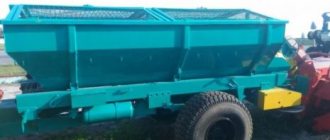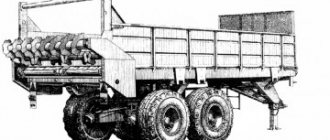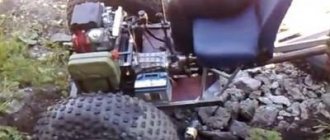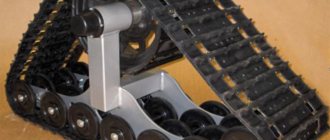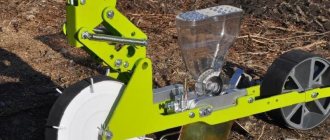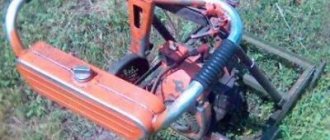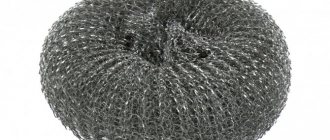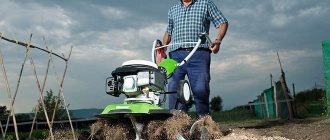Those who grow fruits and vegetables know the importance of a sprayer.
If you are the owner of a mini tractor, you can easily purchase this attachment, or even make it yourself from materials that are in every man’s workshop. A sprayer for a mini tractor performs very important tasks - it helps in the fight for the harvest, spraying plants with solutions against pests, it can be used to fertilize, and also spray crops for the purpose of prevention from various diseases. The equipment is widely used in vegetable gardens, orchards, for processing shrubs, vineyards, and much more.
Short description
Modern fertilizer spreaders are a universal design that consists of important components and multifunctional mechanisms. The main role is played by the diffuser, which has the form of two disks equipped with special blades. Their coordinated rotation in one direction contributes to the uniform application of fertilizers to the soil. In some cases, these blades have additional elements - extensions. Every specialist knows that it is the adjustment of the overall length that allows fertilizer to be applied to the discs as evenly as possible.
Particular attention is paid to attached types of equipment that can be used in combination with tractors of different power. In this case, agricultural technicians give preference to a 100-horsepower or 80-horsepower engine. The final design of the mounted spreader consists of a linkage mechanism and a frame. A bunker is always attached to the top, which is equipped with two funnels. The presence of two loading grids helps prevent a situation where large granules penetrate into the unit. The lower part of the device is equipped with two funnels, which ensure uniform distribution of nutrients.
Experts note that a mounted unit is characterized by the presence of universal distribution discs. If any emergency arises, they can be easily dismantled and replaced. During active operation, the agitator shaft ensures a uniform supply of fertilizers that exit the hopper onto the distribution discs.
Positive sides
In the field of agriculture, the spreader is considered the main technical means of mechanizing the introduction of fertilizer. For gardeners with a large plot of land, this type of equipment allows them to apply nutrients to their plants in precise dosages and evenly.
The need for such technology lies in the fact that every year cultivated plants absorb a significant amount of nutrients from the soil.
To compensate for these losses, it is necessary to rationally use inorganic fertilizers, which contain the following ingredients:
- phosphorus;
- potassium;
- nitrogen;
- impurities that improve the physical, chemical and biological characteristics of the soil.
How to use superphosphate fertilizer, and in what specific cases, is indicated in the article.
Advantages and disadvantages
Each type of agricultural machinery is designed to facilitate agricultural work, mine spreader. fertilizers are no exception. Before you start using it, you need to familiarize yourself with all the advantages and disadvantages.
The positive characteristics of the unit include:
- Possibility of applying nutritional compositions over large areas.
- Regardless of the spreader model used, fertilizer is supplied only while the vehicle is moving.
- Rapid movement of complementary feed substances to the main destination.
- There are universal units on sale that provide a function for controlling the amount of fertilizer. The user can always increase the concentration of nutrients where needed. This function is in demand among large landowners, as it saves money.
- The unit ensures quick and uniform distribution of nutritional components over the entire treated area.
Many farmers have discovered another possibility for using this technique - seed dispersal. The only drawback is that it is not cheap. If the farm is just developing, purchasing such a unit will be problematic. Because of this, the owner has to do everything manually.
Fertilizer spreaders, their purpose
Mineral fertilizer spreaders are presented as additional attachments, the use of which significantly speeds up the process of fertilizing the soil or sowing seeds.
Similar devices are:
- mounted
- trailed
Sometimes spreaders are used to add sand to the soil or to spread it in winter during icy conditions. Such equipment provides high efficiency for any type of use.
Some of the models are heavy and capable of performing various functions. These types of spreaders are irreplaceable.
Spreaders provide precise dosage and uniform distribution of mineral mixtures over the surface of the cultivated areas, which contributes to positive results during the cultivation of agricultural products.
The use of this type of equipment reduces the cost of purchasing the required nutritional supplements.
Some of the spreaders are attached to agricultural machinery using special attachments. This type of technology helps to enrich the soil with minerals using the scattering method.
Types of spreaders
Experts are accustomed to classifying modern fertilizer spreaders according to several criteria. First of all, by the type of components added to the soil. The technique can be used for organic or mineral formulations. Even if a farmer decides to make a fertilizer spreader with his own hands, such a unit must be able to work with the following forms of materials:
- Granules.
- Dust-like fertilizers.
- Liquid solutions.
- Manure compositions.
All units differ in functionality. With their help you can grind, mix, and transport. Depending on the final method of fastening, such units are :
- Trailed. Attached to the tractor.
- Self-propelled. Fully automated, do not require connection to other installations.
- Manual. Suitable for small areas.
- Semi-trailer. They are universal, can work either independently or in combination with other machines.
- Mounted. Installed on powerful agricultural implements.
Recently, more and more farmers have decided to make a mounted mineral fertilizer spreader with their own hands. Thanks to this, you can get a high-quality and durable unit, spending much less money.
Don’t forget about homemade manual spreaders, which are based on wheelbarrows or carts. Such a unit operates on a pneumatic, pendulum or centrifugal principle.
Pendulum units
The production of such systems occurs exclusively in foreign companies. Because of this, their popularity is at a rather low level. The main working unit is not represented by disks, but by a special swinging tube. To ensure that this part is of high quality and durable, it is made of the best quality plastic. The swinging of the tube is provided by reciprocating movements that come from the shaft.
Pendulum spreaders are inferior to disk models in terms of productivity. They produce a lot of noise and distribute fertilizer unevenly across the land.
Trailed systems
This category of units distributes fertilizers and seeds well even with minimal pressure. The equipment consists of a conveyor, a body, a drive mechanism and a dispenser. To control seeding, the user must change the speed of the conveyor and the width of the gap. Statistics show that trailed mineral fertilizer spreaders are considered the most common. Their appearance resembles a trailer. However, the accuracy of the distribution of introduced materials leaves much to be desired.
Mounted installations
Manufacturers claim that the power of such units is in no way inferior to a conventional tractor. The design is a special attachment with a frame and a spacious hopper. The spreaders are equipped with discharge grates that prevent large particles from entering the internal compartment of the unit. The lower part consists of special funnels that ensure uniform application of fertilizers.
Many landowners choose this model because it contains spreading discs. When they fail, they can be easily replaced. When the unit is actively used, previously loaded fertilizers fall onto the discs moving in the opposite direction. Thanks to this, the applied materials are distributed as evenly as possible.
Disc mechanisms
Such units have universal stainless steel blades, disks, and a driveshaft. The advantage is that the user can independently control the intensity of work from the tractor cabin using special dampers. Changing their position regulates the concentration of mineral or organic components. The presence of special mixers and safety nets eliminates the possibility of large particles getting into the inside of the installation.
Classification
Mineral fertilizer spreaders are mechanized complexes for dispersing bulk and granular fertilizers on the soil surface, as well as substances necessary to change the alkaline-acid composition of soils and their density structure - dry limestone, gypsum and sand.
Manure spreader at work
According to the method of aggregation with base machines, spreading devices are divided into trailed and semi-trailer machines made using wheeled chassis and mounted mechanisms mounted on tractors.
Depending on the technique of fertilizing, the units that carry out this operation are divided into:
- Mechanisms for introducing substances into the soil during plowing or sowing - plows, seeders and chisel-cultivator complexes equipped with special mechanisms;
- Complexes for post-arable application of fertilizers, spreading mineral and organic substances over the soil surface, which include spreaders of various types, as well as units for applying liquid substances.
Functionality
Most often, the spreader is filled with those mineral fertilizers that belong to the salts of chemical elements - sodium, potassium, phosphorus. They penetrate the soil as deeply as possible over the entire treated surface. Before starting work, you need to pay attention to the external condition of the equipment. If necessary, you need to replace faulty parts, tighten fasteners, and treat all rubbing mechanisms with special oil.
The operating principle of the spreader is as follows:
- The necessary nutrient materials with a high level of humidity, with the size of individual fractions not exceeding 7 mm, are poured into the bunker. If the agronomist decides to use larger fractions, this is fraught with arching. Important mechanisms of the unit may stick, which will disrupt the entire work process. Loading is done using a tractor or truck loader.
- Sieve. This is a durable mesh that is installed in the bunker itself. Its main task is to prevent the entry of large particles of fertilizer and foreign objects.
- Fertilizers. All mineral and organic components reach the diffuser thanks to the shutters. It is he who is responsible for ensuring that nutrients enter the soil in a fan-shaped manner.
- Multifunctional drive of working parts. The operation of this system depends on the power take-off shaft. The frame houses the fasteners for all assembly elements of the spreader. The frame itself is represented by a powerful tubular structure. A special attachment, which is fixed with bolts, helps to increase the volume of the bunker.
The drive of the unit is presented in the form of a single-stage bevel gearbox and a telescopic cardan shaft. The presence of universal dampers helps the farmer control the intensity of work. The main control mechanism for the mounted spreader is located under the bottom of the hopper. The main emphasis is on the movable damper, the rod and the lever attached to it. Using this technique, you can fertilize not only fields, but also gardens and pastures. Thanks to this, farmers have an excellent opportunity to feed row crops and winter crops.
When the inspection of the equipment is completed, you can set the fertilizer supply rate. To do this, fill the hopper with the necessary mineral or organic components in the required dosage. It all depends on the established standards of concentration and path length.
Homemade snow shovel
Barrel for making a blade To make your own snow shovel for the Neva walk-behind tractor, first, you will need to collect the necessary tools and materials. So, we need:
- old steel barrel 200 l;
- an iron strip with dimensions of approximately 850x100x3 mm;
- 1 m of square pipe with a cross section of 40x40 mm;
- bolts M10, M12 and M8, as well as washers and nuts;
- set of metal drills;
- pliers;
- set of wrenches;
- a sheet of thick durable rubber;
- small but thick steel sheet;
- grinder with metal discs;
- welding machine;
- hand electric drill.
After all the tools, materials and drawings have been collected, you can begin to make a blade for the walk-behind tractor with your own hands. The simplest solution would be to make a ladle from an old 200 liter barrel, since it initially has optimal roundness. In this case, there is no need to heat the metal sheets and bend them, giving them the desired shape. So, you will need an old barrel, the lid and bottom of which must be cut off with a grinder. The resulting pipe should be cut lengthwise into three identical segments. These two thirds need to be joined together along the contour using a welding machine, and the remaining third should be cut with a grinder into strips that will be used to ensure sufficient rigidity. Attach one strip to the sides of the shovel, and distribute several pieces evenly along the entire length of the blade.
Design of a homemade snow plow Now, to further strengthen the entire structure of the plow, you need to make a knife at the bottom of the bucket. To do this you will need an iron strip with dimensions 850x100x3 mm. Using an electric drill, drill three holes in the knife with a diameter of 5-6 mm and a distance between them of 100-120 mm. This is necessary to strengthen the rubber gasket, which will prevent the bucket from damaging the road surface. The knife is attached to the working edge of the bucket using a bolted connection. After assembling the snow shovel and knife, it is necessary to make and install a mount for the blade. Weld a piece of pipe to a homemade walk-behind blade in the center of the structure. In the middle of the pipe, use welding to secure a semicircle made of a thick sheet of metal and make several holes in it to set the required rotation angles and fix the walk-behind tractor blade. Next, you need to take another piece of square pipe and make an L-shaped holder from it. The short side of this holder is installed in a rotating semicircle, and the second end of the pipe is bolted to the frame of the power unit. To adjust the height of the blade, use two bolts screwed into the recess of a square pipe, which is welded to the hitch and placed on an L-shaped holder. The video shows a snow shovel for a walk-behind tractor and how to use it.
To make equipment you must have the following materials:
Self-production
Many farmers are interested in how to make a mineral fertilizer spreader with their own hands so that it has the necessary performance properties. First you need to prepare all the mechanisms and tools. It is best to take a simple box and make 11 holes in it. Subsequently, they will be covered with rotating plates. There should be 2 holes above each plate. To control the supply of fertilizers during operation, you need to install special valves. Two wheels will be used as support.
During operation of a homemade diffuser, the rotational moment will be transmitted from the wheels to the plates, and only then to the agitator and ejector shaft. Thanks to this, fertilizers will be distributed evenly into the cultivated soil. The effectiveness of this procedure depends on how often the user stirs up the nutrients.
The demand for such equipment is due to the fact that the speed of crop development depends on the high-quality and timely application of fertilizers. A universal spreader helps to significantly save time and effort when performing agricultural work.
How to make a manual mineral fertilizer spreader with your own hands
The manual device needs to be pushed across the field independently, and this is not very convenient. Nevertheless, it is quite possible to do it yourself. The basis of the device is a pair of running wheels and a box for nutritional mixtures.
11 holes are drilled in the bottom of the box and covered with plates that rotate. A pair of ejectors are installed above the plates.
In addition, you can connect a turner. During movement, the wheels transmit torque to the plates, ejector shaft and agitator.
With this design, fertilizers fall from the box onto rotating plates and then relatively evenly onto the ground.
